
P.D. GRIFFIN
ENCYCLOPEDIA OF MODERN BRITISH ARMY REGIMENTS
The blue peaked cap is worn with the corps badge, the figure of Mercury (the winged messenger) holding a caduceus, poised on a globe, with the corps motto Cert a cito (Swift and sure) below7, and a crown above. Mercury was the brainchild of Maj Beresford of the Telegraph Battalion RE in 1884.
Yeomanry regiments transferred to the corps in 1920 as its TA element were allowed to keep their own badges and some other items of uniform.
No. 1 dress 'blues' are plain except for the broad scarlet RE stripe on the trousers and the black belt worn by the Signals with this order of dress.
In combat/barrack dress signallers may be identified by their age-old sleeve flash, which is diagonally divided white/blue, and the corps stable belt, which is banded light blue and green with a blue dividing stripe to represent communications over sky, land and sea respectively.
The corps band is issued with full dress, which is RE pattern, except that the busby has a scarlet bag and plume, the scarlet tunic a simple cuff design, and spurs are worn. Dress spurs testify to the cavalry origins of the corps and the mounted sections that operated in the field with cable carts before mechanisation in the 1930s.
The corps quick march, adopted in 1926, is an arrangement of the old folk tunes Begone Dull Care and Are You Not from Newcastle? The slow march HRH The Princess Royal was adopted in 1936 in honour of Princess Mary, Colonel-in-Chief of the RCS until her death in 1965.

The famous White Helmets motorcycle display team demonstrating the skills of Royal Signals' dispatch riders, developed over a century of service. (MoD)
After the formation of the corps in 1920 its private soldiers were given the rank of signaller. Their trades evolved from mounted linesmen and drivers, and motorcycle dispatch riders, to radio operators, systems/installation technicians, area systems operators, specialist electronic warfare operators and electricians. The Yeoman of Signals plans and supervises the deployed communications structure.
TA squadrons are rich in the customs of the volunteer regiments converted to signals units at various times during the twentieth century. Elements of 37 Signal Regiment adhere to their own version of the loyal toast.
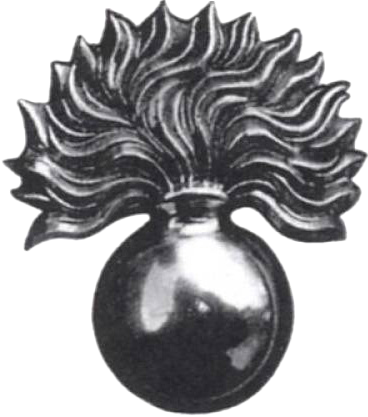
The first companies of the regiment were formed at Bruges in 1656 from loyal supporters of Charles II in exile. When he came to the throne in 1660 Charles commissioned a new regiment for his personal protection at home and in 1664 he brought the two together in a body soon to become the 1st Regiment of Foote Guards.

Grenadier Guards, 1952; the officer's black armband was worn for the late King. Note the regimental white plumes
In 1815 the 1st Guards were instrumental in defeating Napoleon's Guards at Waterloo, and were honoured by the Prince Regent in the same year as the 1st or Grenadier Regiment of Foot Guards to mark their repulse of the Grenadiers de la Garde in the battle.

A GG drummer in the role of stretcher-bearer at the Queen's Birthday Parade in 2005. Drummers of the Foot Guards still wear the elaborate royal pattern lace (white with blue fleur-de-lys) of the eighteenth century
The Guards' blue cap has a scarlet band and the grenade badge adopted with the Grenadier title in 1815. In the same year all members of the regiment were issued with a bearskin cap fitted with a white side plume, another sign of the Grenadier (since 1768) and the start of the bearskin custom in the Guards. The white plume is said to represent the puff of white smoke that used to come out of early grenades when primed.
The royal cypher, adopted with the Garter belt when Queen Victoria was crowned in 1838, appeared on pouches, belt plates and officers' pagris before it replaced the grenade on shoulder straps in 1920. It takes the form of the reigning monarch's initials (VR, GR or ER), reversed and interlaced. A royal cypher of this kind has appeared on the buttons of Grenadier Guards' uniforms since 1855.
The march, Scipio, was presented to the 1st Guards by Handel prior to its first performance in 1726, eighty years before the adoption of a second slow march, The Duke of York, who was the Colonel-in-Chief of the regiment at the time.
The quick marches, British Grenadiers and The Grenadiers' March, long played for Grenadier companies of the army, were adopted with the change of title in 1815. The regimental band was first formed in 1665.
Waterloo Day (18 June) has been celebrated every year since 1816, principally because of the battle's importance to the regiment's identity. It was a custom of the Grenadier Guards to march 'at attention' when passing the Duke of Wellington's house at Hyde Park Corner.
Inkerman Day (5 November) was commemorated in the 3rd Battalion to honour 'The Sandbags', the 100 Grenadiers who won the imagination of the army with their dogged defence of the Sandbag Battery at Inkerman in 1854.
The senior company of the regiment has the extra duty of being the sovereign's own guard, an honour instituted by Charles II. It requisitions the tallest guardsmen for the Guards of Honour at coronations, state occasions and funerals. The company commander has always been known as Captain of the Kings (or Queen's) Company irrespective of his true rank. A special standard carried in the presence of the monarch is regarded as a personal gift and is buried with the sovereign, a tradition begun in 1910.

The Coldstream was formed in 1650 as Monck's Regiment, with companies drawn from Heselrigge's at Newcastle and Fenwick's at Berwick.

Coldstream in guard order, 1912. Note the regimental spacing of the tunic buttons and the lance sergeant's regimental cap
In 1660 George Monck marched his regiment from the Scottish border town of Coldstream to London in order to restore law and order that had suffered after the death of Cromwell. Londoners knew them by their town of origin - 'The Coldstreamers'. Early in 1661 the regiment was paraded on Tower Hill and formally disbanded as a parliamentarian regiment, but promptly re-engaged in the service of Charles II as the Lord General's Regiment of Foote Guards, though it continued for many years after purged of royalists. Even today it is the only one of the seven Guards regiments whose colonel has no royal title. After the death of Monck in 1670 the regiment's nickname was invoked and they were officially given as the 2nd or Coldstream Regiment of Foote Guards.

2nd or Coldstream Guards re-enactment society in the dress of the 1770s, when the regiment served in the American War of Independence
Armed with the knowledge that the 1st Foot Guards had actually been raised after them, the Coldstream never really accepted their 2nd Guards status, and in 1783 a group of officers formed the Nulli Secundus Club to highlight the fact that they were 'second to none'. By 1817 the 2nd Guards title was dropped and the terms Coldstream, Coldstreamers, 'Coleys' (but never 'Coldstreams'), were used thereafter.
The Guards' blue peaked cap has been regimentalised with a white band and welt since the 1860s. Its badge is the Star of the Order of the Garter, bestowed on the regiment by William III in 1696. The officers' 'cap star' is in the old elongated form with the cross of St George in red.
Buttons are worn in pairs in this regiment to conform with the Foot Guards' code of seniority first displayed on the red coat around 1770, when the Coldstream was still listed as the 2nd Guards.
Full dress is Foot Guards' pattern, the bearskin with a scarlet plume on the right side to contrast with those of the Grenadiers. A Tudor rose emblem, first worn on the bearskin adopted in 1832, was later transferred to shoulder straps on the scarlet tunic. The senior NCOs' colour badge, worn on the right sleeve, shows the elongated star and the sphinx campaign honour.
The quick march Milanollo, authorised to the Coldstream in 1882, is named after two violinist sisters who toured Europe in the 1840s. The slow march, Figaro, was adopted in 1805 from Mozart's opera of the same name.
The Band of the Coldstream Guards dates from about 1770.
Coldstream customs stem from early service. St George's Day celebrates the Garter Star badge with its cross of St George; recruiting is done in the areas through which Monck's Regiment marched on their way to London in 1660 - the north-east and the Midlands, and in Brigade Order it is said the Coldstream preferred not to parade second to the Grenadier Guards but opted for the other places of honour, left of the line or rear on the march.
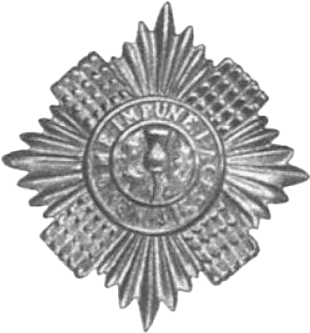
A 'Scotch Regiment of foote Guards' was raised on a commission of Charles I in 1642, but after the defeat of his son at the Battle of Worcester in 1651, it was dispersed by Cromwell and not rebuilt again for another nine years.
The first companies of Scotch Guards, raised in 1660 to guard the castles at Edinburgh and Dumbarton, were accepted onto the English establishment by James II in 1686, subordinate to the 1st and 2nd Guards. In spite of efforts made by Queen Anne to get the Scots' long history recognised in the hierarchy of the Foot Guards they were finally placed as the 3rd Guards in 1713, the 'kiddies' of the brigade.
In 1831 bearskins were issued and the regiment was forced to adopt the title Scots Fusilier Guards as a reason to wear them, but in 1877 the name was simplified to the Scots Guards (SG).
The Guards' blue peaked cap is distinguished with a red, white and blue diced band and a red welt around the crown. Officers have a gold welt. The cap badge is the Star of the Order of the Thistle.
Full dress is Foot Guards' pattern, the bearskin with no plume, originally a statement on the regiment's standing in the Foot Guards (junior of the three and therefore centre of the line, not a flank regiment like the other two). The scarlet tunic has a white thistle collar badge and buttons set in groups of three, in accordance with the Foot Guards seniority custom. The senior NCOs' colour badge depicts the star badge and the sphinx awarded to the regiment in 1802 for its part in the Egyptian campaign of the previous year.

SG lieutenant (with cased colour) and the escorts to the colour at Waterloo for the 150th anniversary of the battle. Guards cap peaks were less severe in 1965
SG pipers were issued with the feathered Highland bonnet in 1928 to level them up to the bearskins of the regiment. Otherwise their dress has not changed since Queen Victoria's day: a blue doublet with castellated wings, a kilt and plaid of Royal Stuart tartan, white hair sporran with three long black tails, and hose of red and green marl.

Pipers and drummers of the Scots Guards at Wellington Barracks, c. 1992
Regimental marches are the familiar Highland Laddie, which dates back to the seventeenth century, and The Garb of Old Gaul (1770) in slow time:
In the Garb of Old Gaul, with the fire of Old Rome,
From the heath-covered mountains of Scotia we come...
Musicians employed by the regiment in the early eighteenth century were replaced by a full band about 1816.
The principal day of celebration, St Andrew's (30 November), is celebrated in traditional manner wherever the regiment is stationed, with the piping in of the haggis. In the officers' mess the Picquet Officer leads the way in to dinner and there acts as mess president.
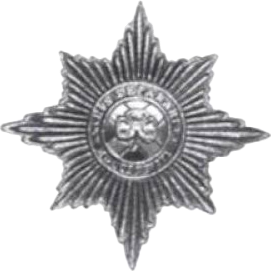
The regiment was created in 1900 on the wishes of Queen Victoria to mark the bravery of her Irish soldiers in the Boer War. It was known then as 'Bob's Own' after their colonel, Lord Roberts.
The Guards' blue cap, regimentally enhanced by a green band and welt, is badged with the Star of the Order of St Patrick.
Full dress is Foot Guards' pattern, the bearskin with a plume of St Patrick's blue on its right side, the scarlet tunic with a white shamrock collar badge. Buttons are stamped with a harp and crown, and worn in groups of four.
Pipers are dressed in traditional Irish green caubeen (with the blue hackle), green doublet, saffron kilt and green socks.
The regimental quick march is the popular St Patrick's Day, the slow march Let Erin Remember. Other airs of Irish extraction, some from the disbanded Irish regiments, are now played as company marches.

Irish Guardsmen in 2000: lance sergeant drummer (standing, left), colour sergeant (centre) and pipe major (standing, right). (Grenadier Publishing)
On St Patrick's Day (17 March) shamrock is distributed to all members of the regiment, a custom requested by Queen Victoria to commemorate its service in the South African war. The presentation ceremony was instituted by Queen Alexandra in 1901 and continued after her death in 1925 by Princess Mary. Queen Elizabeth The Queen Mother presented the shamrock every year from 1968 until her death in 2003.
'The Micks' have paraded an Irish wolfhound mascot since 1902. The dogs are traditionally named after ancient Irish chieftains.
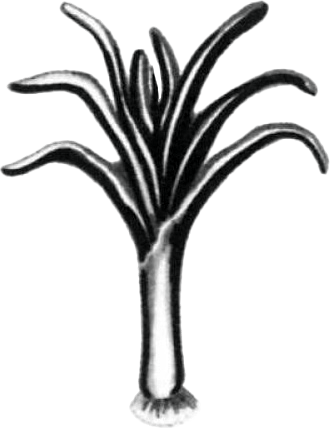
The regiment was formed by royal warrant in 1915, with 'Taffs' hurriedly drawn from other units to enable it to parade on St Davd's Day. The early nickname 'The Foreign Legion" was inspired by these Welshmen with their various cap badges.
The Guards' blue cap has a black figured braid band and leek badge.
Full dress is Foot Guards' pattern, the bearskin with a white/green/white plume on the left side, the scarlet tunic with a white leek collar badge. The Welsh Guards rank fifth in the Foot Guards and wear their buttons grouped in fives to show this. On the buttons are a crown and leek encompassed by a scroll inscribed Cymru Am Byth (Wales for ever). The senior NCOs' colour badge (right sleeve) has the Welsh dragon and motto.
The regimental quick march, The Rising of the Lark, is an arrangement of an eighteenth-century Welsh song, probably from the pen of the harpist David Owen. Men of Harlech and Men of Glamorgan are played in slow time.
On St David's Day (1 March) leeks are presented by a member of the royal family. In 1969 Princess Anne made her first solo engagement doing this.
The senior company of the regiment is called the Prince of Wales's Company and its old nickname 'The Jam Boys' tells of the austere time after the Second World War when it made an application for extra jam rations to compensate guardsmen in its ranks.
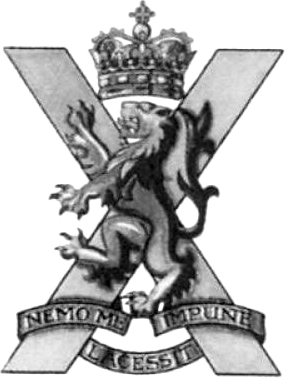
THE ROYAL REGIMENT OF SCOTLAND
This 'super regiment' was blueprinted in the 'Future Army Structures' of 2004 to accommodate the six famous-name Scottish infantry regiments. It was the most controversial of the planned mergers of that year and the motto Nemo me impune lacessit (Let no one provoke me with impunity), which was displayed by three of the condemned regiments, spoke for the mood of the Scottish people in 2004.
Highland regiments had been formed in times of war from 1689 but the Jacobite uprisings in the north of Scotland guaranteed that none achieved permanence until well into the next century. Foot regiments raised in the Lowlands and employed against the Jacobites were given a place in the army and stood among the senior regiments of infantry. The Royal Scots were born in 1633 under a warrant of the Privy Council for service with the French Army, and on their return to Charles II gained seniority of the infantry. The Royal Scots Fusiliers came out of the troubles of 1678, when the Earl of Mar founded a regiment to police the lawless clans and the Presbyterian Covenanters, a sect persecuted by the Stuarts. When that dynasty came to an abrupt dip in 1688 the Covenanters found themselves on the right side of the law- and readily pledged their martial arm, called the Cameronians, to the new King's cause to put down the Jacobites. A new regiment, quickly mustered in Edinburgh to help the King's forces in Scotland, later evolved to become the King's Own Scottish Borderers (KOSB).

Men of the 7th (Service) Battalion Seaforth Highlanders returning from the front at the Somme, July 1916
Of the sixty-one Highland regiments raised between 1689 and 1803 only eleven secured a permanent position in the army. The first of these eleven was assembled at Aberfeldy in 1739 from independent companies of Highland watch that had been set up fourteen years before. It was known as the 'Black Watch' because of the dark government tartan worn by the lads of these companies. Other famous Highland regiments, the Seaforth, Gordon, Cameron and the Argyll and Sutherland, were enlisted later on in the century as a direct response to the colonial and French wars. The Highland Light Infantry, deprived of its Highland dress in 1809, was often categorised with the Lowlanders, and eventually merged with a Lowland regiment.

Bandsmen of the Royal Highland Fusiliers in No. 1 dress, c. 1988
Historic regimental headquarters are located all over Scotland and the Borders:
Royal Scots (Royal Regiment) - Edinburgh
Royal Scots Fusiliers - Ayr
King's Own Scottish Borderers - Berwick-upon-Tweed
Cameronians (Scottish Rifles) - Lanark
Black Watch (Royal Highland Regiment) - Perth
Highland Light Infantry - Glasgow
Seaforth Highlanders - Fort George

Member of the Napoleonic Association in the garb of the 42nd Royal Highland Regiment at a 'living history' show in the 1990s
Gordon Highlanders - Aberdeen
Queen's Own Cameron Highlanders - Inverness
Argyll and Sutherland Highlanders - Stirling
We have much more interesting information on this site.
Click MENU to check it out!
∎ cartalana.com© 2009-2025 ∎ mailto: cartalana@cartalana.com